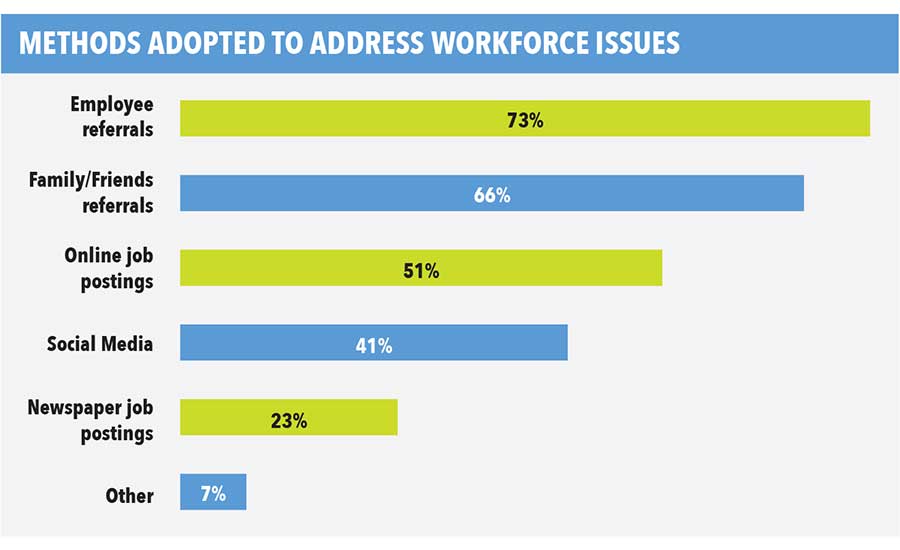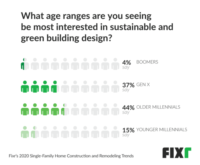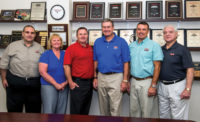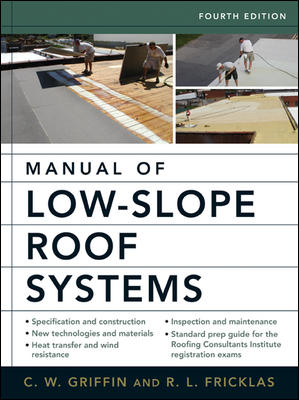Provided by SOPREMA.
Commercial Roofing in 2020 and Beyond

As the start of a new decade approaches, SOPREMA USA’s Matt Davis and a team of product managers sat down to discuss key issues impacting the roofing trade. They shared their thoughts and ideas on employee recruitment, increased product performance and sustainability.
Shrinking Labor-Driven Workforce
Skilled labor outlooks are grim, while demand for work is far exceeding supply.
According to experts in the labor and industry sectors, two of the reasons for the continued skilled labor shortage include changing demographics and public misperceptions of the trades.
First, baby boomers are retiring from the skilled labor workforce at a rapid rate while their children and grandchildren are looking elsewhere for jobs, causing construction firms to face an uphill battle in bringing workers through the door, especially young recruits.
2019 Commercial Roofing Trends Report: Continued Confidence
Whether new or old to the roofing industry, roofing contractors learn very quickly that the fruitful fortune of one good year could be followed by dry spells the very next year, or two, or more. Forecasting properly is essential for anyone looking to stay relevant in one of the most rapidly-changing segments of the construction world.... (read more)
By next year, millennials will make up half the global workforce, but many do not have experience or interest in the construction industry. Millennials of all income backgrounds entering the workforce prefer to go to a four-year college, wanting high-tech jobs and other enticing careers offering flexible schedules and appealing cultures.
Millennials also have global options and unprecedented mobility, meaning they are not restricted by geography or time. However, these issues can be good news, because this group is willing to relocate for the right opportunity, which can greatly expand recruiting efforts. Their comfort and skill with technology can also be of benefit, balancing traditional labor with digital tools to streamline estimating, ordering, and introducing new methods of marketing like social media and responsive websites.
Experts also believe a contributing factor to the labor shortage is the negative perception of construction careers. Some of the biggest myths contractors hear about working in the commercial building industry are that construction jobs are “dirty,” and construction is a job — not a career.
To clear up these myths, contractors can emphasize that construction offers good pay, opportunities for advancement and the ability to learn new skills on the job to help advance their career. Additionally, the labor shortage has caused many contractors to look into new products and technologies as a problem solver, making these jobs more enticing.
Providing competitive salaries and challenging job assignments is a starting point to recruiting younger employees. Creating a workplace culture that is attractive — with compelling benefits and a strong, friendly internal communication strategy — can also assist in recruiting and retaining employees.
Increasing Demand for Sustainable and Restorative Products
Sustainability is a part of the mission of most organizations, especially as environmental awareness grows. Exploring sustainable options allows companies to drastically reduce harmful emissions while developing new technologies. This trend makes sense, as savvy customers demand sustainable, eco-friendly and renewable products. This phenomenon has been the main driver in every major worldwide market, including the construction and manufacturing sectors, according to the International Energy Agency’s “Renewables to Lead World Power Market Growth to 2020.”
Architects, building owners and property managers are realizing the cost benefits of sustainable roof restorations. Other factors, such as the prominence of reflective coatings, VOC-restricting legislation and sustainable products, are also shaping the marketplace. In fact, some cities now require taller buildings to include a green roof or a combination of a green roof and solar energy to help with stormwater management, air quality improvement and local temperature reduction. Some state efficiency programs are even driving demand for cool roofs by requiring buildings to reflect sunlight and absorb less heat.
As customer demand grows for products that are environmentally conscious, manufacturers must offer materials that meet this need so they do not miss out on a lucrative and loyal demographic.
Educating Decision Makers on Warranties
While there are many factors that are helping to shape the roofing industry, it often comes down to long-lasting, high-quality products and warranties.
Many architects, designers and building owners evaluate warranties based on length. Unfortunately, the length of a roof’s service life has little to do with the written warranty — the service life is truly a function of how the roof was designed, installed and maintained.
It is important to remember that the initial cost of a roof is only a portion of the total cost of ownership over its lifespan. Emphasis should be placed on the performance, reliability, functionality and full life cycle of roofs.
In general, long-lasting, serviceable roofs have everything to do with having a knowledgeable and experienced architect or engineer design the roof and observe its installation, selecting a competent and qualified roofing contractor to install it, and having a dedicated and organized building owner to maintain it.
Looking Ahead
As customer needs and market trends evolve, so too must the commercial roofing manufacturers who supply solutions to meet these needs. Successful companies will strive for strategic innovation to revolutionize the marketplace, greatly impacting their short- and long-term success. In the end, roofing companies that incorporate consumer behavior trends with deliberate invention will have a bright 2020.
Looking for a reprint of this article?
From high-res PDFs to custom plaques, order your copy today!








